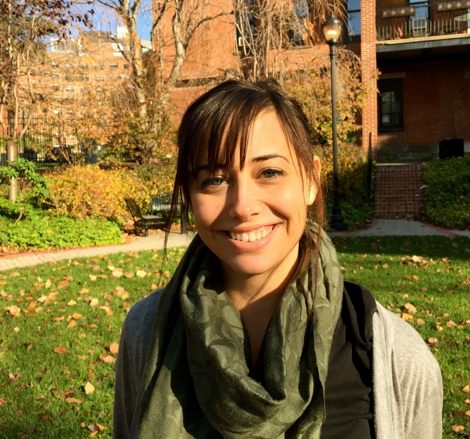New Faculty Snapshot: Alison Patteson
The new research assistant professor of physics comes to Syracuse from the University of Pennsylvania

Alison Patteson joined the Department of Physics in January, coming to Syracuse after earning her doctorate in mechanical engineering and applied mechanics from the University of Pennsylvania in 2016. She credits good mentors and a longtime interest in hands-on projects for her research path.
A National Science Foundation graduate research fellowship supported Patteson’s Ph.D. research on biophysical problems involving swimming bacteria. Her dissertation won the 2018 Dissertation Award in Statistical and Non-Linear Physics from the American Physical Society. Patteson says she’s pleased to have found a research home in the University’s Soft and Living Matter Group, a multi-disciplinary program dedicated to research and education in soft and biological matter.
How did you end up working in this field? What spurred your interest in science, particularly physics?
I chose to study physics as an undergrad because I enjoyed mathematics and its application to science. There is a predictive power in physics and I am driven by curiosity. I also had great mentors in high school and college that encouraged me to pursue physics. I enjoyed doing research projects with concrete things that I could pick up and hold. My first projects were on granular materials, like sand, and I had the opportunity to play with it one summer at the University of Chicago during a research experience for undergrads. I was motivated to work on problems with applications and decided to study fluid mechanics in graduate school.
Tell us about your current research interests.
My research interests include problems in cell motility and active living matter. My research aims to identify how cells navigate and respond to the physical features of their environment (mechanical properties, presence of boundaries and cell-cell contacts) to achieve important biological functions, such as cancer metastasis, wound healing and biofilm formation. My research uses microfluidic technology, single-molecule experiments, knock-out cell models and concepts from non-equilibrium statistical physics to investigate the dynamics of swimming bacteria and mammalian cell motility.
You mention cancer and wound healing. Tell us more about the potential practical applications of your research.
For example, many tumor cells express high levels of the protein vimentin. Vimentin is an intermediate filament, which is one of the main cytoskeletal polymers that give cells mechanical stability. Recently, we found that vimentin decreases cell speed in confining microchannels that mimic small pores in tissues. These results highlight a role of vimentin in cell motility, which has implications for understanding its potential as a target for cancer therapy.
What do phenomena like the dance of the murmuring starlings or the “tuna tornado” formed by jackfish schools say about patterns on the molecular level? Is that what you mean by “the predictive power in physics”?
Collective motion and pattern formation emerge in biological systems over an impressive range of length scales, from flocking birds and swarming bacteria to molecular motors inside the cell. This common motif suggests underlying physical principles that influence the dynamics of living systems. Models based on simple rules for particle interactions have been widely successful in describing a range of active systems. Such models can provide insight and predictions for the molecular level, such as spindle formation during mitosis.
Physics has gotten a big PR boost in recent months, thanks to the high-profile gravitational waves research. How do you see that affecting the field in the short and long terms?
The gravitational waves research is really exciting and is great for the department. There is a lot of enthusiasm! My hope is that such cutting-edge research will excite young people and encourage them to pursue science careers.
I was drawn to the physics department at Syracuse University due to its strength in soft matter and active matter research. The department has many leaders in this field, and I am excited for the opportunity to join the faculty.
